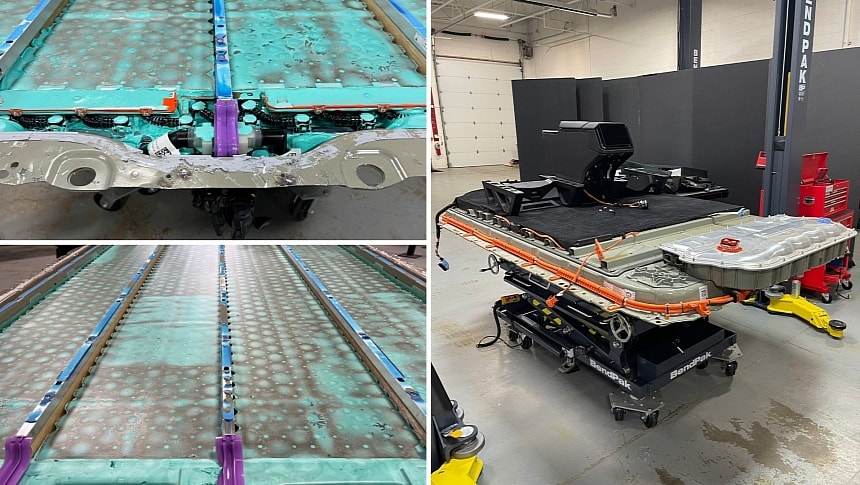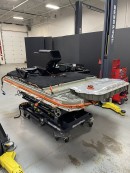Industry veteran Sandy Munro and his team continued the Tesla Cybertruck teardown with the battery pack. Cracking open the Cybertruck's structural battery revealed intriguing details. Most importantly, the pack appears to be half-empty, which means Tesla deliberately delivered the Cybertruck with a lower range than advertised.
During Battery Day 2020, Tesla unveiled the 4680 cells, the first battery cells it designed from the ground up. Until then, Tesla relied on battery cells supplied by its partners, mostly 18650 cells from Panasonic (for the Model S and Model X) and 2170 cells from Panasonic and LG (for the Model 3 and Model Y). The 4680 cells are much bigger than either of them.
In 2020, Tesla announced that a new manufacturing technique, "dry batter electrode," would allow up to 50% lower production costs. This resulted from reducing the manufacturing time by eliminating several time-consuming and chemical-heavy operations from the manufacturing process. A new silicone anode was also expected to significantly increase battery performance. However, four years after the original announcement, Tesla 4680 cells don't feature a silicone anode, and it's unclear whether the dry electrode process has been implemented.
To add insult to injury, 4680 cells have proven a disappointment in real life, at least the first generation used in the Model Y produced at Giga Texas between 2022 and 2023. People who bought a 4680 Model Y complained about very long charging times, most probably due to the poor thermal characteristics of the larger cells. Tesla improved the design with the second generation of the 4680 cells installed in the Cybertruck. Still, not all problems seem to have been solved.
Most notably, charging speed is still a concern for many people, as the Cybertruck hasn't impressed in this regard. Many expect switching to an 800-volt charger to speed things up, but it's unclear if this would help much. What is certain is that Tesla changed the battery pack design significantly since the Model Y time, presumably to offer better thermal control in the case of the Cybertruck.
This has been revealed after veteran Sandy Munro and his team cracked open the Cybertruck battery pack. A short video on the Munro Live channel showed what's inside the pack. One of the most obvious things we see is a lot of empty space, possibly for a second layer of cells. If this is indeed true, it could indicate that the battery pack capacity could be much higher, which is why Tesla promised over 500 miles of range for the Cyberbeast.
The fact that Tesla launched the Cybertruck with a smaller battery capacity could have two explanations. One of the reasons was to keep costs down. A double-layer battery pack would've increased the price of the Cybertruck, which is not exactly affordable to begin with. The second reason could be to build as many Cybertrucks as possible, considering the limited 4680-cell production.
Of course, the extra headroom inside the battery pack could be for increased rigidity or other purposes that are not obvious to us mortals. However, there's another intriguing engineering choice Tesla made. The cells appear to be organized in modules separated by beams, which means this is not a cell-to-structure design. It could be that Tesla opted for this solution to satisfy the tougher Cybertruck requirements, considering it's a capable towing vehicle. Hopefully, the Munro team will reveal more details when they release the full teardown video.
In 2020, Tesla announced that a new manufacturing technique, "dry batter electrode," would allow up to 50% lower production costs. This resulted from reducing the manufacturing time by eliminating several time-consuming and chemical-heavy operations from the manufacturing process. A new silicone anode was also expected to significantly increase battery performance. However, four years after the original announcement, Tesla 4680 cells don't feature a silicone anode, and it's unclear whether the dry electrode process has been implemented.
To add insult to injury, 4680 cells have proven a disappointment in real life, at least the first generation used in the Model Y produced at Giga Texas between 2022 and 2023. People who bought a 4680 Model Y complained about very long charging times, most probably due to the poor thermal characteristics of the larger cells. Tesla improved the design with the second generation of the 4680 cells installed in the Cybertruck. Still, not all problems seem to have been solved.
Most notably, charging speed is still a concern for many people, as the Cybertruck hasn't impressed in this regard. Many expect switching to an 800-volt charger to speed things up, but it's unclear if this would help much. What is certain is that Tesla changed the battery pack design significantly since the Model Y time, presumably to offer better thermal control in the case of the Cybertruck.
This has been revealed after veteran Sandy Munro and his team cracked open the Cybertruck battery pack. A short video on the Munro Live channel showed what's inside the pack. One of the most obvious things we see is a lot of empty space, possibly for a second layer of cells. If this is indeed true, it could indicate that the battery pack capacity could be much higher, which is why Tesla promised over 500 miles of range for the Cyberbeast.
The fact that Tesla launched the Cybertruck with a smaller battery capacity could have two explanations. One of the reasons was to keep costs down. A double-layer battery pack would've increased the price of the Cybertruck, which is not exactly affordable to begin with. The second reason could be to build as many Cybertrucks as possible, considering the limited 4680-cell production.
Of course, the extra headroom inside the battery pack could be for increased rigidity or other purposes that are not obvious to us mortals. However, there's another intriguing engineering choice Tesla made. The cells appear to be organized in modules separated by beams, which means this is not a cell-to-structure design. It could be that Tesla opted for this solution to satisfy the tougher Cybertruck requirements, considering it's a capable towing vehicle. Hopefully, the Munro team will reveal more details when they release the full teardown video.
Sneak peek…video coming soon! pic.twitter.com/VqeygFQD4C
— Munro Live (@live_munro) April 2, 2024






